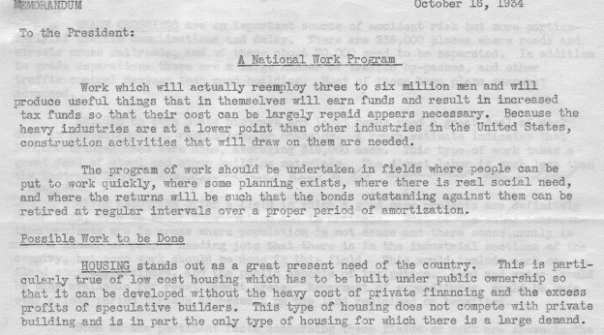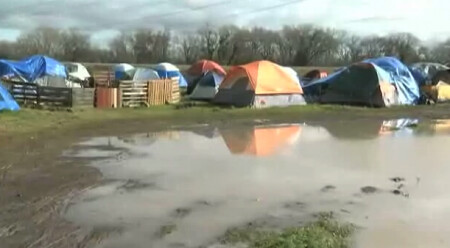“O reason not the need! Our basest beggars
Are in the poorest thing superfluous.
Allow not nature more than nature needs,
Man’s life is as cheap as beast’s.” (Lear, II iv)
The Problem:
If there is any one area of American life that best expresses the adage “poverty in the midst of prosperity,” it must be housing. Even as thousands upon thousands of homes now stand empty, vast swathes of speculative suburban developments along the highways and hills of California turned into ghost towns, homelessness has increased. In Washington D.C, the number of homeless families has increased in the last year by 15%, with similar figures being reported in New York City and other metropolitan centers. Even when the sub-prime boom was spreading home-ownership wide and far and actually beginning to make headway against the unequal distribution of housing in America, in 2006, 8.8 million households were paying more than half their income in rent (I was probably one of them). Major systemic problems (the lack of affordable housing and workforce housing near where people work, the need to in-fill versus sprawl, racial and class discrimination) were not being addressed, even when the market was flush.
It isn’t flush now. If ever there was a need for proof that “spatial mismatch” and “credit discrimination” exist, we can find it in the fact that at a time when thousands of houses are empty rotting shells, that people who want and need housing are being turned away by banks who have suddenly become paragons of fiscal rectitude.
At the same time, the national unemployment rate currently stands at 9.4%. Within the construction industry, unemployment stands at 21%. Within California, the situation is even worse, with an overall unemployment rate of 11.5%, and a construction industry that’s down 150,000 jobs from last year. While I fully expect that the stimulative effect of the American Recovery and Reinvestment Act of 2009 will begin to ameliorate this situation within the next six months, I personally was calling for an even larger jobs bill at the time.
I think we can tackle both problems at the same time.
The Solution:
Public employment programs – like the Works Progress Administration (WPA)- have a special affinity for has been called “light construction.” In its eight year existence, the WPA built nearly 40,000 public buildings, and rehabilitated or improved another 80,000, despite the fact that most WPA workers actually did road construction. Those 120,000 buildings included 6,000 new schools, 2,170 school expansions, and 31,000 school modernizations, 322 new or improved hospitals, and 6,400 public office buildings. Even if you divide it up yearly, it still comes out to 15,000 buildings a year, done with only a fraction of its 3.5 million strong workforce. In my own research, I have found that the one thing that the WPA wasn’t able to do, that administrators and experts within the WPA like Emerson Ross, Jacob Baker, Alan Johnstone, Nels Anderson and a handful of other almost completely forgotten New Dealers wanted to do, was build housing.

As you can see in the above memo written by Jacob Baker, the plan to expand the New Deal’s employment program to 3-6 million men (far bigger than the WPA eventually managed), also went hand in hand with an attempt to deal with the chronic market failure to provide affordable housing in the city core. This insight, the drive to kill two birds with one stone, is one that we should follow today.
My suggestion would be for the Federal government, along with the state and local governments, to go into areas where the housing market has failed (large proportions of renters paying more than 50% of income in rent, housing values far out of sync with median incomes, large numbers of abandoned foreclosed properties, or a lack of affordable housing in general) and do three things: first, to restore and rehabilitate derelict housing and second, to build new housing units where new housing is needed in central cities, and third, to destroy “ghost towns” that are now nothing of blight in such a way that as much of the materials can be saved as possible.
If we were establish a Housing Progress Administration (HPA) to employ 5 million unemployed workers (many of whom would no doubt be former construction workers) to do this, and we paid $24k a year (assuming an overhead rate of 30%, which is actually 10% higher than the WPA”s historic 20% rate), making a deal with states and localities to pitch in for the cost of land and materials, it would cost approximately $155 billion per year. If we kept the program going for the next two years, at which point economic growth would start to transition into employment growth, it would cost $310 billion – less than half the cost of the stimulus bill. And it would create at least 5 million jobs, nearly the total number of jobs lost in this recession.
Now the question becomes, what do we do with this new housing? I have a few suggestions:
- Selling At/Below Cost – the wonderful, undiscovered virtue of the public sector is that it doesn’t have to make a profit. If we were to sell the new/reclaimed housing at or below the cost of construction, we could begin to reverse the impacts of the sub-prime collapse, by getting low to medium income families back into housing with low-rate, FHA-backed mortgages, instead of crooked, ballooning loans. Moreover, by moving thousands or even millions of people back into housing would help defray the cost of the construction program, pushing it well below $155 billion.
- Giving Away Housing – in cities with high rates of homelessness, one of the most successful recent programs has been to simply give homeless people housing for free. For the 17% of the homeless who work, it simply gets them over the obstacle of putting together first-and-last plus security deposit; but for many more, getting a mailing address and a phone number, a place to clean their clothes, and so forth is a huge helping hand towards getting a job and staying off the streets. Even if we don’t make any money back on giving away housing, we would be solving a major social problem and a major human crisis.
- Establishing Rental Co-ops – finally, we should recognize that home-ownership is not the only route to economic security, and that our public policy needs to do more to ensure that renters get the same kind of government assistance that home-owners get from the FHA, HOLC, tax breaks, and other public policies. Thus, in addition to providing new housing for sale, the HPA should also create a variety of apartment buildings and single homes for rent, working with local housing groups (yes, like ACORN) to establish local rental co-ops who would operate and maintain the units.
In the face of manifest human need and the gross waste of our current system, what else can we do but help?


You must be logged in to post a comment.